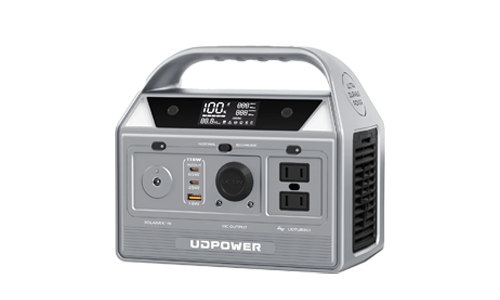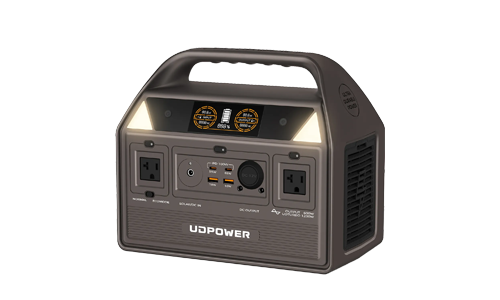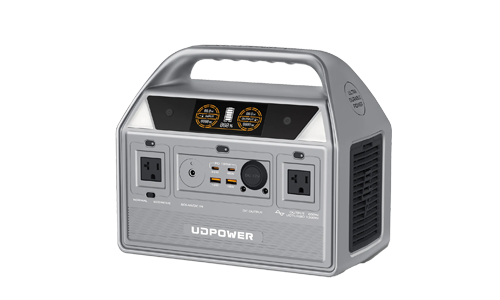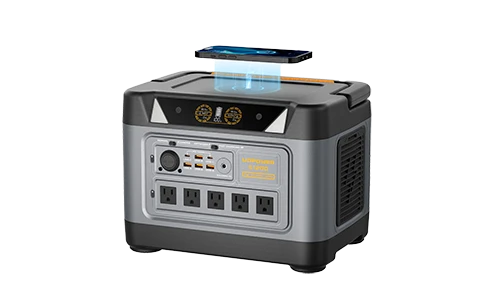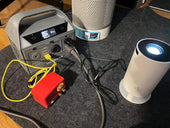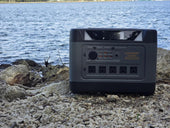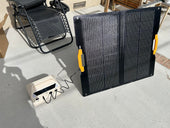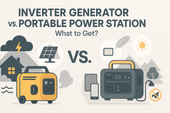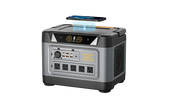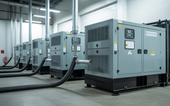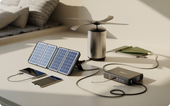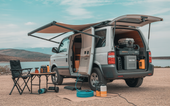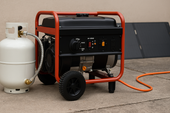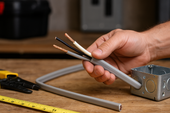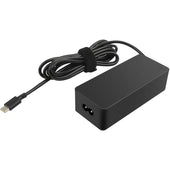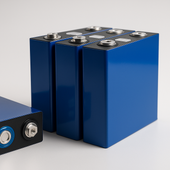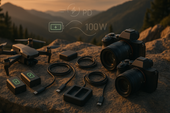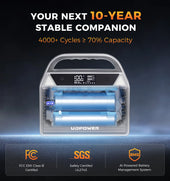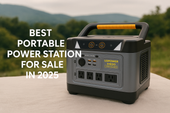How to Power Starlink Off-Grid: 5 Ways to Charge a Starlink Internet System
ZacharyWilliamPractical power paths, right-sized batteries and solar, wiring tips, and a calculator to plan your runtime—whether you’re in an RV, van, boat, cabin, or on a remote job site.

1) Know Your Starlink Kit & What Drives Power
Starlink terminals vary: Mini is most efficient (USB-C PD power), Standard sits mid-pack, while Performance/Flat HP draws more due to a larger phased array and in-motion capability. Real-world consumption shifts with ambient temperature (dish heater), workload, boot/search spikes, extra network gear (mesh nodes, switches, cameras), and conversion losses if you’re flipping DC→AC→DC.
2) Off-Grid Energy Budgeting (The Only Math You Need)
Daily Energy
Log a mix of idle, calls/streaming, and overnight behavior to pick a realistic average wattage.
Battery Capacity
DoD = depth of discharge (e.g., 0.8 for 80%). Efficiency includes inverter/DC losses.
Solar Array
0.7–0.8 folds in MPPT/controller/wiring/angle/temperature losses. Be conservative for winter.
3) Way #1 — USB-C PD Direct (Starlink Mini)
When it shines
- Ultralight/mobile day work, quick deployments
- Highest efficiency—no inverter needed
Things to check
- PD profile must meet Mini’s requirement
- Cold weather may affect PD negotiation—plan a backup cable/source
4) Way #2 — Portable Power Station (AC) → Starlink Power Supply
Fastest to deploy: your portable power station’s AC output feeds Starlink’s original power supply (PoE/adapter). One box can power Starlink plus laptops, lights, cameras, and more.
Pros
- Plug-and-play, easy to scale with foldable solar
- Also powers your other AC/DC devices
Cons
- Expect ~10–15% conversion losses (DC→AC→DC)
- Size inverter to cover startup/search spikes
Runtime (h) ≈ (Battery Wh × usable DoD × inverter/DC efficiency) ÷ average Starlink watts
5) Way #3 — Alternator + DC-DC → House Battery → Inverter → Starlink
Best for vans/RVs that drive regularly. A proper isolated DC-DC charger replenishes your house battery while driving; Starlink runs from the inverter when parked.
- Use isolation & correct fusing; keep cable runs short to limit voltage drop
- Add solar/shore power for stationary days
6) Way #4 — Solar PV + MPPT + Battery → Inverter/PD → Starlink
Quiet and scalable for cabins/seasonal sites. Plan conservatively for winter, shading, and weather. Tilt-adjustable mounts boost winter yield at higher latitudes.
7) Way #5 — Generator/Shore Hybrid → Charger/Inverter → Battery Buffer
Works in any weather: run a generator or shore charger to top up batteries, then enjoy quiet battery operation in between. Ventilate well and follow CO/fire safety rules.
8) Quick Comparison Matrix
| Path | Efficiency | Noise | Complexity | Weather Resilience | Best For |
|---|---|---|---|---|---|
| USB-C PD (Mini) | ★★★★☆ | Silent | ★★☆☆☆ | ★★☆☆☆ | Ultralight/mobile day work |
| Portable Power Station (AC) | ★★★☆☆ | Silent | ★★☆☆☆ | ★★★☆☆ | Fast setup, mixed devices |
| Alternator + DC-DC → Battery | ★★★★☆ | Low driving | ★★★☆☆ | ★★★☆☆ | Vans/RVs with regular driving |
| Solar + MPPT + Battery | ★★★★☆ | Silent | ★★★☆☆ | Weather-dependent | Long stays, cabins |
| Generator/Shore Hybrid | ★★★☆☆ | Noisy while charging | ★★★☆☆ | ★★★★★ | Storms, winter, job sites |
9) Interactive Off-Grid Power Planner
Estimate daily energy, battery size, solar watts, and runtime—tailored to your Starlink use and climate. (Verify exact product specs before purchase.)
Starlink Kit
Tip: include router/mesh if they’re on.
Daily Use & Climate
Efficiency & Solar
Battery Runtime
Always verify exact capacities/specs on the product pages.
Results
| Adjusted Average Power | — W (includes climate overhead) |
|---|---|
| Hours Online (after Sleep) | — h/day |
| Daily Energy | — Wh/day |
| Recommended Battery (1 day) | — Wh @ DoD×Eff |
| Solar Array Needed | — W (at your sun-hours & solar efficiency) |
| Runtime on Selected Battery | — hours |
UDPOWER Picks for Typical Scenarios
C400 — Compact Day Work

- LiFePO₄ portable power station
- Capacity: 256 Wh; Rated output: 400 W; Peak up to 800 W
Great for Starlink Mini sessions and light loads.
S1200 — Flexible All-Rounder

- LiFePO₄ portable power station
- Capacity: 1,190 Wh; Output: 1,200 W; Fast charge ≈1.5 h
Good headroom for Standard kits + laptop/monitor; solar-friendly.
210W Portable Foldable Solar Panel

- Rated output: 210 W; up to ~22% conversion; IP65 water-resistant
- Foldable; adjustable stand for better sun angle
Pair ~200–240 W per ~500 Wh/day Starlink budget in fair weather.
Specs summarized from official product pages; check exact details before purchase.
10) Wiring & Hardware Essentials (Safety First)
- Cable gauge & length: size for current; keep runs short to cut voltage drop/heat
- Fusing: protect every positive line near the source; use rated breakers on solar strings
- Grounding/bonding: follow your inverter/charger manual and RV/boat/cabin standards
- Ventilation: inverters/chargers/batteries need airflow; avoid sealed compartments
- Weatherproofing: mind IP ratings, drip loops, strain reliefs, and UV-resistant ties
11) Practical Ways to Extend Runtime
- Enable Sleep Schedule during off-hours
- Use Automatic dish heating; avoid always-on preheat
- Improve sky view to reduce reacquisition spikes
- Trim the LAN: disable unused mesh nodes/switches
- Prefer DC direct (Mini) or reduce AC↔DC hops
- Schedule big downloads/updates during charging windows
- Keep firmware updated; re-measure occasionally
- Short, adequate-gauge cables; clean connectors
- Shade and ventilate gear in hot weather
- Right-size the kit to your needs
12) Troubleshooting
- Boot failures/dropouts: undersized inverter, poor cables, loose connectors
- Winter high consumption: heater running long; add panel/battery or hybrid charging cycles
- Underperforming solar: shading, dirty panels, wrong tilt, MPPT out of range
- Vehicle charging warnings: no isolation, wrong fuse, or cable too thin causing sag
- Overheating: cramped enclosures—improve airflow or derate loads
13) Budget Snapshots
- Lightweight Mobile: USB-C PD pack (300–500 Wh) + 120–160 W foldable panel → Mini for several hours/day
- Weekend RV: 700–1200 Wh portable power station + 200–240 W panel → Standard kit daily sessions + laptops
- All-weather Cabin: 3–5 kWh battery + 1–2 kW solar + generator hybrid → Performance kit 24/7 year-round
14) Conclusion
- Start from Wh/day, then size battery, solar, and inverter headroom
- Pick the path that fits your mobility and climate
- Build cold-weather and conversion margin; measure, refine, and go


